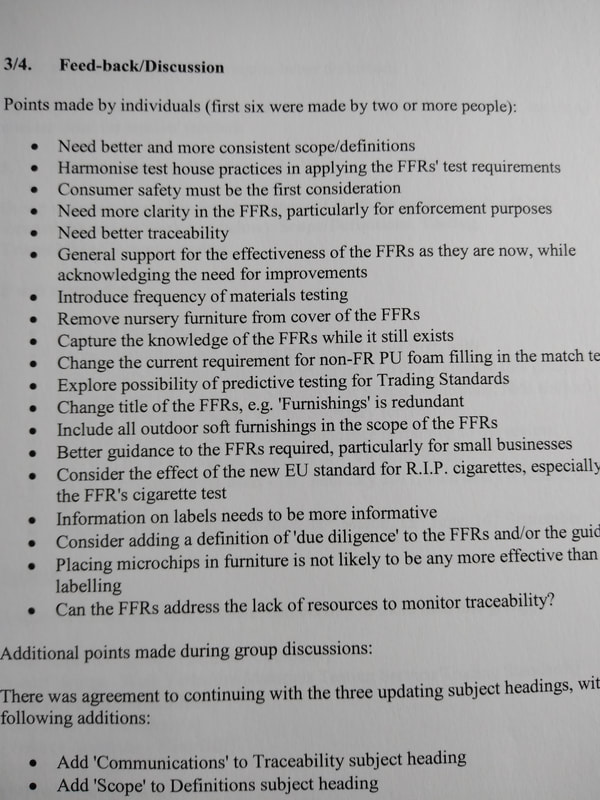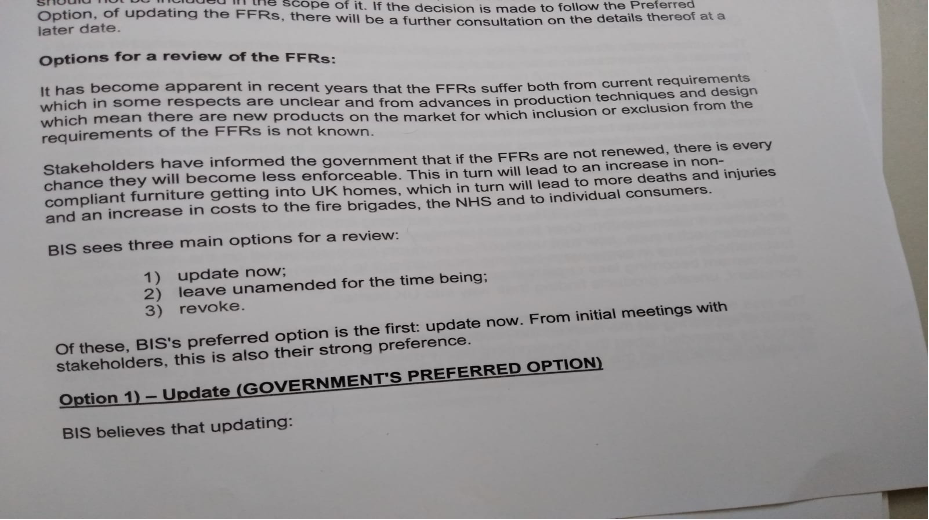I am looking at a fat folder of notes from and about meetings that took place between the Department for Business and a very wide range of stakeholders towards reviewing the Furniture Regulations. They cover a period of 18 months from around December 2010 to June 2011. There are masses of details and suggestions from experts on every aspect of furniture fire safety. They cover many meetings of the main Advisory Group and three sub-groups looking at Traceability, Testing and Definitions.
In his Introduction to the 7 December 2010 meeting of the Advisory Group, Mitchell Leimon (head of the Product Safety Team, now the OPSS, at BIS) said:
"BIS is very keen that this review is a collaborative and open process". And a glance at all these notes confirms that it was indeed. For some years now, however, there has been virtually no collaboration on the furniture regulations. And the new proposals from the OPSS have been largely invented by them at the last moment with little to no reference to any of this good work done so long ago. For example, this meeting note then lists points made so far by the Group (see photo above).
Fourteen years on and NONE of these points has been dealt with, and are mostly not dealt with at all by the new OPSS consultation proposals (although including outdoor furniture fully in scope has now been proposed).
Many of them appear to have completely escaped the OPSS's notice, like "Harmonise test house practices in applying the FFRs' test requirements". In fact the practice continues of furniture manufacturers simply trawling around the test houses, gathering 'fail's until they hit one that scores a 'pass'. The OPSS knows – or rather it should know – that the Food Standards Agency has the power to make test houses give up their logs of tests made in order that they can discover which companies are cheating in this way.
As for "Capture the knowledge of the FFRs while it still exists" – well, I'm quoting here from knowledge that I'm fairly certain has not been capture by the OPSS; buried alive more like!
The point is that many of the people and organisations involved in these meetings are still involved today. So, why aren't they protesting about the incredible lack of progress made since 2011? Why aren't they objecting to all that time and effort they wasted informing the government of what should be changed in the regs?
Well, unfortunately, the OPSS can get away with this because manufacturers and retailers are terrified that if they object, then it will be made apparent to the public that they have knowingly done nothing about preventing customers being poisoned in their own homes at least since 2014 when the government proved the regulations are not effective.
Why does the OPSS want to continue backing safety measures it knows do nothing but poison customers and make fires more toxic? Because the number one motive of civil servants, individually and collectively, is to cover one's back. These new proposals guarantee further long delays by which time all involved at the OPSS in these regulations will have moved on to other jobs and therefore out of the firing line.
As for all this knowledge that has been ignored: well, either the OPSS is in possession of it or it isn't. If the former, then why aren't they sharing it all with the world? If the latter, why aren't they asking if anyone has copies that they can add to the current review? The fact is, it's unlikely they have copies for two reasons: first, for many years electronic files at the Department for Business were/are badly stored and/or lost, therefore in effect unrecoverable; second, for the past nine years or so a culture has developed in government and the civil service of not keeping notes and records. Why this is the case should be obvious by now.


 RSS Feed
RSS Feed